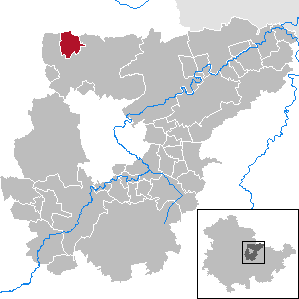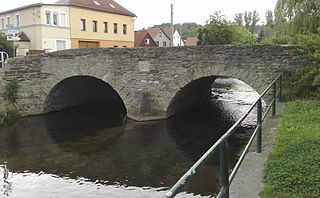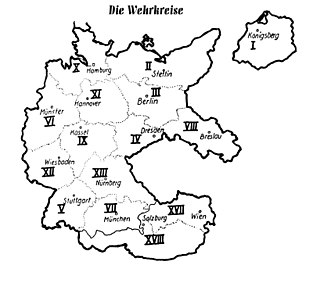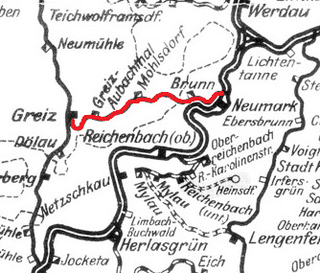
Thuringia, officially the Free State of Thuringia, is a state of Germany. In central Germany, it covers 16,171 square kilometres (6,244 sq mi), being the sixth smallest of the sixteen German States. It has a population of about 2.15 million inhabitants.
Jordan is a country in the Middle East.

The Neumark, also known as the New March or as East Brandenburg, was a region of the Margraviate of Brandenburg and its successors located east of the Oder River in territory which became part of Poland in 1945.
Neumark comprised a region of the Prussian province of Brandenburg, Germany.

The White Elster is a 257-kilometre (160 mi) long river in central Europe, right tributary of the Saale. Its source is in the westernmost part of the Czech Republic, near Aš. After a few kilometres, it flows into eastern Germany where it cuts through the Vogtland in a "deep and picturesque valley". In Germany it flows through the states of Saxony, Thuringia and Saxony-Anhalt. The White Elster flows through the cities of Plauen, Greiz, Gera, Zeitz, Pegau and Leipzig, and into the river Saale in Halle.

The Ilm is a 128.7 kilometers (80.0 mi) long river in Thuringia, Germany. It is a left tributary of the Saale, into which it flows in Großheringen near Bad Kösen.

The Pleiße is a river of Saxony and Thuringia, Germany.

Neumark is a town in the Weimarer Land district, in Thuringia, Germany. It is situated 20 km northeast of Erfurt, and 12 km northwest of Weimar. Neumark is the second-least populous town (Stadt) in Germany, and is the least populous in what was formerly East Germany.

The Orla is a 35 km long river in eastern Thuringia, Germany, right tributary to the river Saale. Its source is near the town Triptis. It flows west through the towns Neustadt an der Orla and Pößneck. The Orla flows into the Saale in Orlamünde, 17 km south of Jena.

During World War II, Germany had a system of military districts to relieve field commanders of as much administrative work as possible and to provide a regular flow of trained recruits and supplies to the Field Army. The Field Army was separate from the Home Command (Heimatkriegsgebiet). The responsibilities of training, conscription, supply, and equipment were entrusted to the Home Command.

The Ulster is a 57-kilometre-long (35 mi) river in Thuringia and Hesse, Germany.

The Itz is a river of Thuringia and Bavaria, Germany.

Georg Neumark was a German poet and composer of hymns.

The Helme is river in central Germany that is about 65 kilometres (40 mi) long and which forms a left-hand, western tributary of the Unstrut in the states of Thuringia and Saxony-Anhalt.

Catherine of Henneberg was a Countess of Henneberg by birth and from 1347 by marriage Margravine of Meissen, Landgravine of Thuringia, etc. She was the wife of Margrave Frederick the Severe of Meissen. Via her, the House of Wettin inherited her father's Franconian possessions.

Apfelstädt is a river which flows for 34 km through Thuringia, Germany.

The Neumark–Greiz railway was a branch line in the German states of Saxony and Thuringia, which was built by the Greiz-Brunn Railway Company. It ran from Neumark in the Vogtland district of Saxony to Greiz in Thuringia, but was closed in 1999.

Mohlsdorf-Teichwolframsdorf is a municipality in the district of Greiz, in Thuringia, Germany. It was formed on 1 January 2012 by the merger of the former municipalities Mohlsdorf and Teichwolframsdorf.
Haide is a hamlet in the municipality of Mohlsdorf-Teichwolframsdorf in the Greiz district of Thuringia, southwest of the hamlet Gottesgrün, located on the Neumark–Greiz railway. The residential area consists of two farmsteads and three other residential buildings.
Gramme is a unit of mass.
This page is based on this
Wikipedia article Text is available under the
CC BY-SA 4.0 license; additional terms may apply.
Images, videos and audio are available under their respective licenses.














